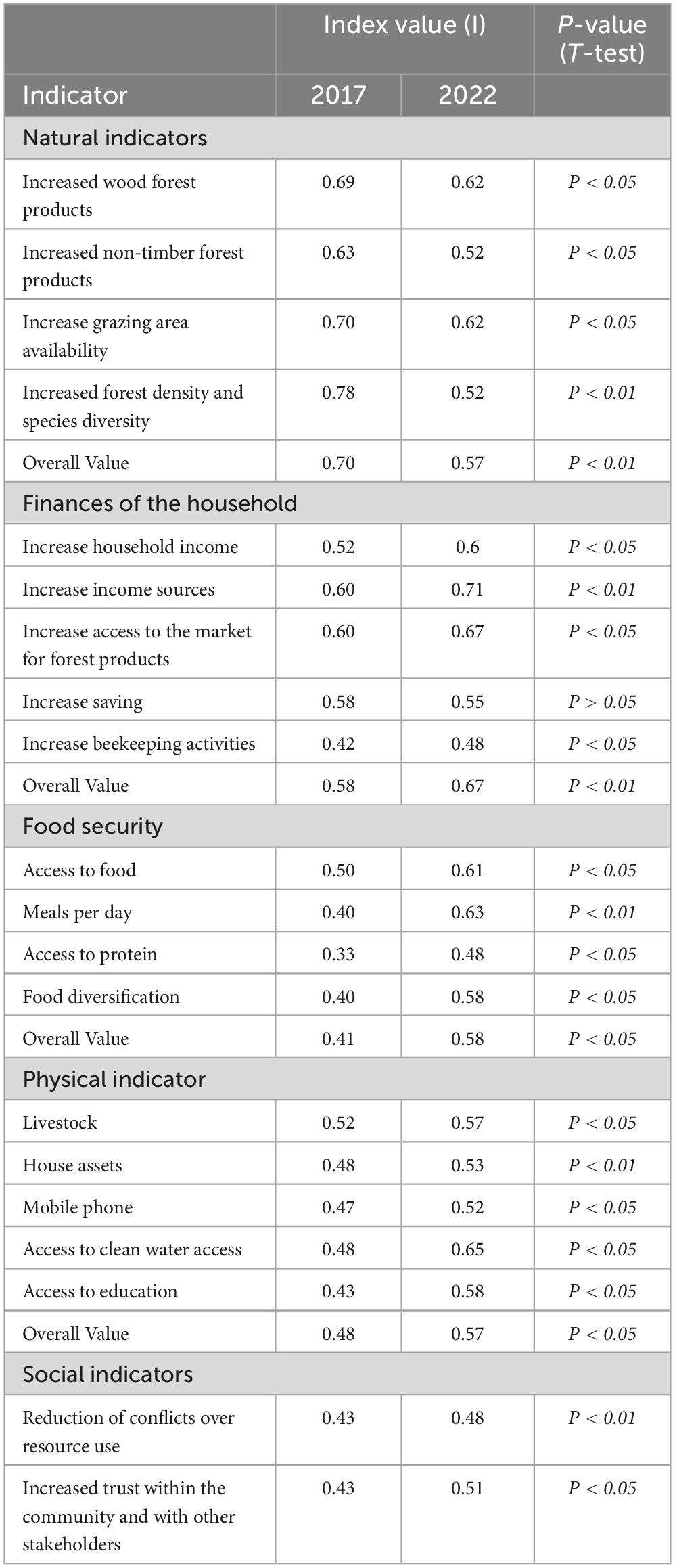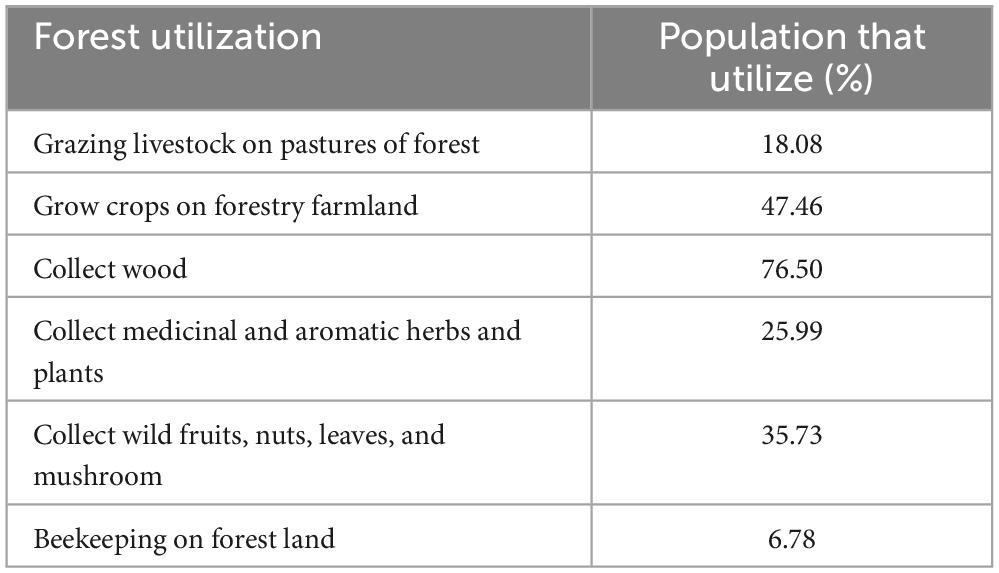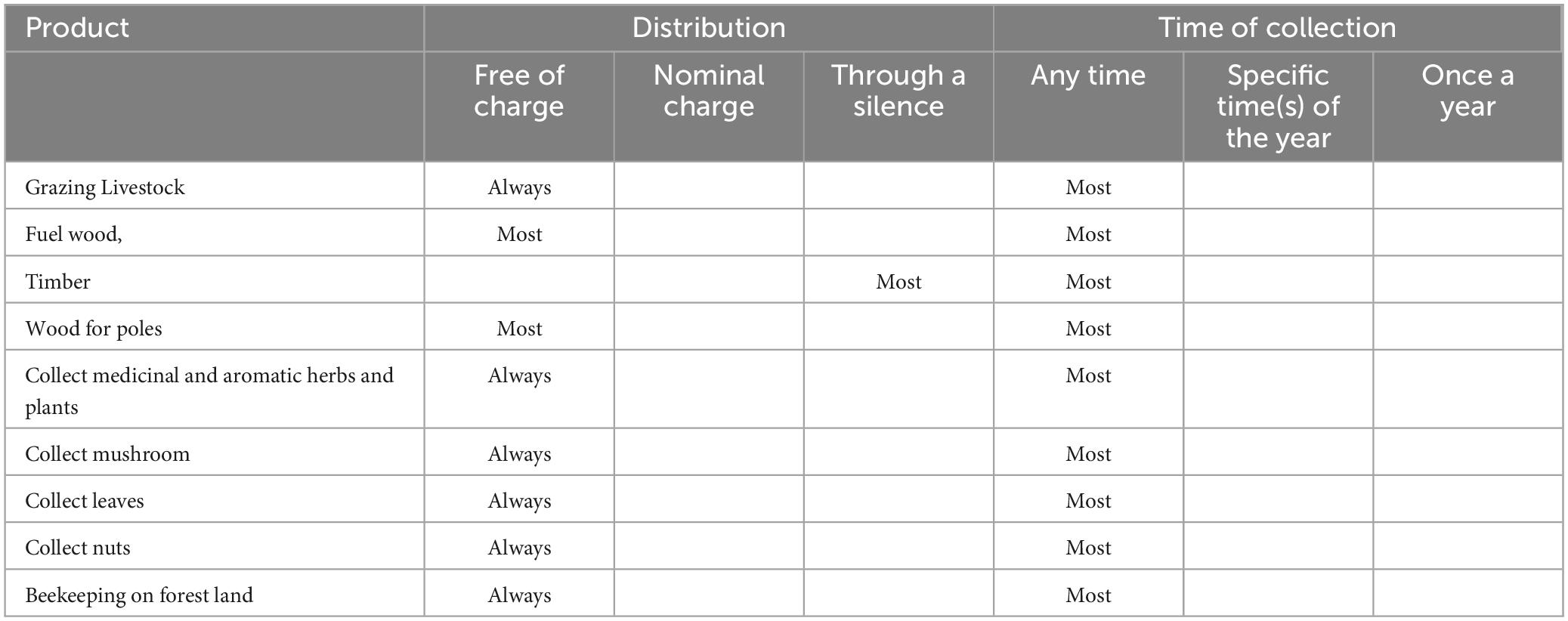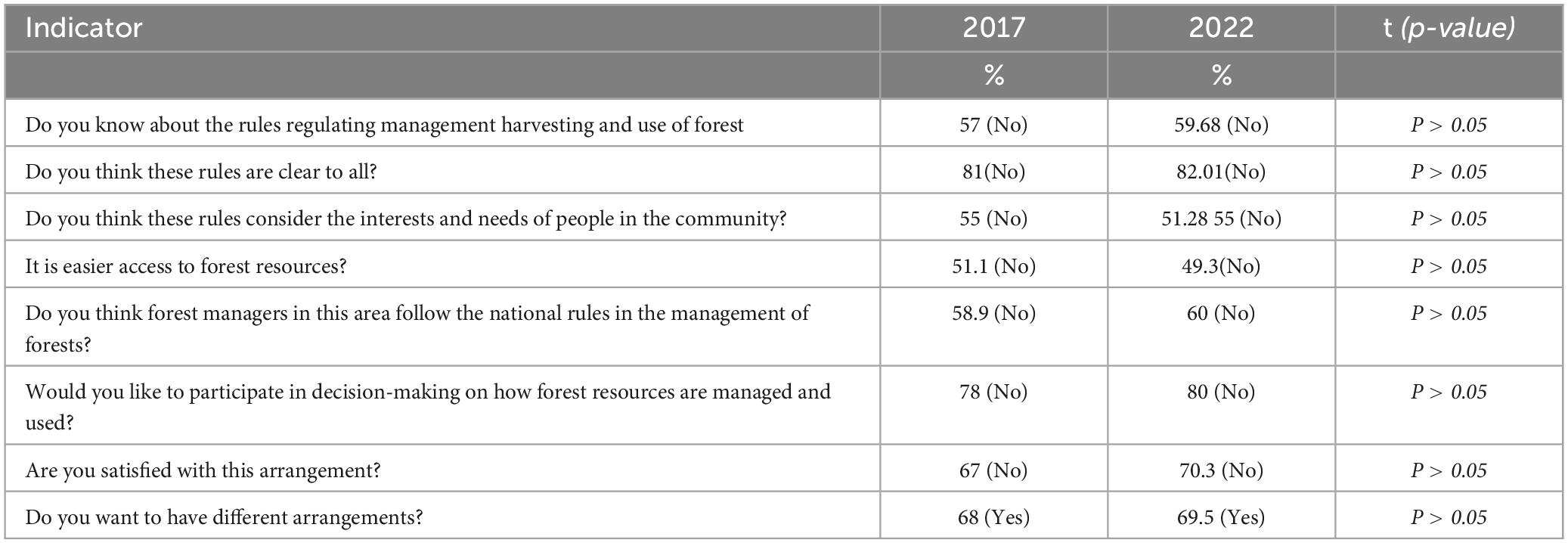- College of Economics and Management, Nanjing Forestry University, Nanjing, China
Over the past years, forests have been crucial in shaping economic development patterns by sustaining livelihoods, assisting in economic restructuring, and encouraging sustainable growth. This study assesses the impact of forestry management practices on regional economic benefits and the livelihoods of rural communities in Ghana, focusing on three forest reserves in the Ashanti Region. A mixed-method research design, incorporating both quantitative and qualitative approaches, was employed. A total of 234 respondents were purposively selected based on their availability and willingness to respond to questions, with data collected using a semi-structured questionnaire. The findings indicate a notable improvement in the standard of living, measured by four indicators: household finances, food security, physical health, and social indicators. Despite these improvements, a significant decrease in forest cover was observed in recent years. The decline in forest cover around the three forest reserves in the Ashanti Region of Ghana was attributed to poor management. Communities reported inadequate management and enforcement of forest policies, with forest managers not adhering to regulations, showing high levels of corruption, a trend consistent in 2017 (58.9%) and 2023 (60%). In summary, there has been a significant improvement in the livelihoods of rural communities around the Tano Offin, Nkrabia, and Afram Headwaters forest reserves in the Ashanti Region of Ghana. However, the management of forest resources remains poor and inefficient, leading to a substantial loss of forest cover. This loss threatens biodiversity and ecosystem services. The government should implement proactive forestry management strategies and promote community-based approaches to enhance community involvement in managing their forest resources.
1 Introduction
Forests have long been pillars of economic development, supporting livelihoods, driving economic transformation, and promoting sustainable growth (Kainyande et al., 2022; Rochmayanto et al., 2023). In Ghana and worldwide, forests continue to provide significant commercial benefits to households, companies, and governments, underpinning protective statutes and policies (Agrawal et al., 2013; Tugume et al., 2015). The FAO reports that forest industries contribute over US$1.5 trillion to national incomes globally, about 1% of the global GDP, and provide formal employment to 0.4% of the global labor force (FAO, 2022). Between 2013 and 2020, Ghana’s forests contributed approximately 1.9 billion Ghanaian cedis (GHS), roughly 312.5 million U.S. dollars, to the national economy, accounting for up to 38% of the income of Ghana’s forest dwellers and about 6% annually to the country’s GDP (Ghana Statistics Service., 2022). Beyond formal employment, forests generate informal work opportunities and serve as economic buffers, particularly in rural areas (Acheampong et al., 2018; Fern, 2018; Wale et al., 2022; Wiebe et al., 2022).
However, the world’s forests are under severe threat from deforestation and degradation, endangering these economic benefits (Hoeinghaus et al., 2009; Ankomah et al., 2020; Muthee et al., 2022). For example, the Amazon has lost around 17% of its forest in the last 50 years, primarily due to conversion for cattle ranching (Shivanna, 2022). Such declines have profound implications for livelihoods and national economies (FAO, 2022; Shivanna, 2022). In Ghana, with a deforestation rate of 2%, the country’s forests could vanish in 25 years (Boafo, 2013; Global Forest Watch, 2024). This challenge is compounded by climate change and increasing demands on natural resources, which are predicted to significantly impact water availability, agriculture, and severe weather events (FAO, 2013; Kaur and Mittal, 2020).
Efforts to conserve forested areas date back to many years ago, but deforestation persists, exacerbated by the industrial era’s high demand for raw materials (Amiraslani and Dragovich, 2013; Kaplan et al., 2009; Redd, 2019). To address this, it is crucial to identify and mitigate the physical, human-induced, and location-specific drivers of forest loss, such as agriculture (Ankomah et al., 2020). The United Nations Framework Convention on Climate Change (UNFCCC) has urged developing countries to focus on land use, land use change, and forestry activities to combat deforestation and forest degradation and contribute to climate change mitigation (Ankomah et al., 2020; Ritchie, 2021). Understanding forest changes and implementing effective policies at both the forest reserve management and national strategic planning levels are essential (UNFCC, 2008; Ankomah et al., 2020; Bayrak and Marafa, 2016; Ritchie, 2021).
Ghana has adopted strategies for sustainable forest management by zoning forests into regimes based on resource availability and specific management objectives (Acheampong et al., 2018; Ankomah et al., 2020). Co-management initiatives have also been introduced to curb forest degradation. Despite these efforts, high deforestation rates continue, threatening many livelihoods, especially in rural areas and biodiversity. Therefore, robust, cross-ecological studies are urgently needed to examine the relationships between forest management, economic development, livelihood outcomes, and biodiversity (Ankomah et al., 2020). For this purpose, this study aims to assess forest management practices, economic gain, and the livelihoods of communities surrounding three forest reserves in the Ashanti Region of Ghana: Tano Offin, Nkrabea, and Afram Headwaters. By examining these factors, the study seeks to contribute to a comprehensive understanding of how forestry management practices impact regional economic benefits, the livelihoods of rural communities, and biodiversity in Ghana.
2 Materials and methods
2.1 Study area
The study was conducted in three forest reserves located in the Ashanti Region of Ghana: Tano Offin, Nkrabea, and Afram Headwaters. The Ashanti Region, situated in southern Ghana between longitudes 0°15’W and 2°25’W and latitudes 5°30’N and 7°28’N, covers 24,389 km2, or 10.2% of Ghana’s total land area. It is the most populous region with 4,780,380 residents, constituting 19.4% of the national population (Figure 1). Nkrabea Forest Reserve, named after a hill in its southeastern corner, spans 8,086 hectares and is managed for sustainable timber production under a forty-year felling cycle. It was selected for this study due to its recent designation for biodiversity conservation following a period of recovery from logging. Tano Offin Reserve, the largest in the Atwima Mponua District, covers about 516 square kilometers and is situated in Ghana’s wet semi-equatorial forest zone. It features a mix of deciduous, semi-deciduous, and evergreen forests, with primary vegetation being semi-deciduous (Derkyi et al., 2021; Ghana Statistics Service., 2022). This area experiences significant rainfall from March to July, with a peak in May, and a secondary rainy season from September to November. Average annual rainfall ranges from 1,700 to 1,850 mm, with a dry and hot period between December and February (Ghana Statistics Service., 2022). Afram East Headwaters Forest Reserve is located in the moist semi-deciduous zone and is notable for its unique biodiversity, including valuable and rare flora and fauna (Taylor, 1960). It also serves as a catchment area for the River Afram.
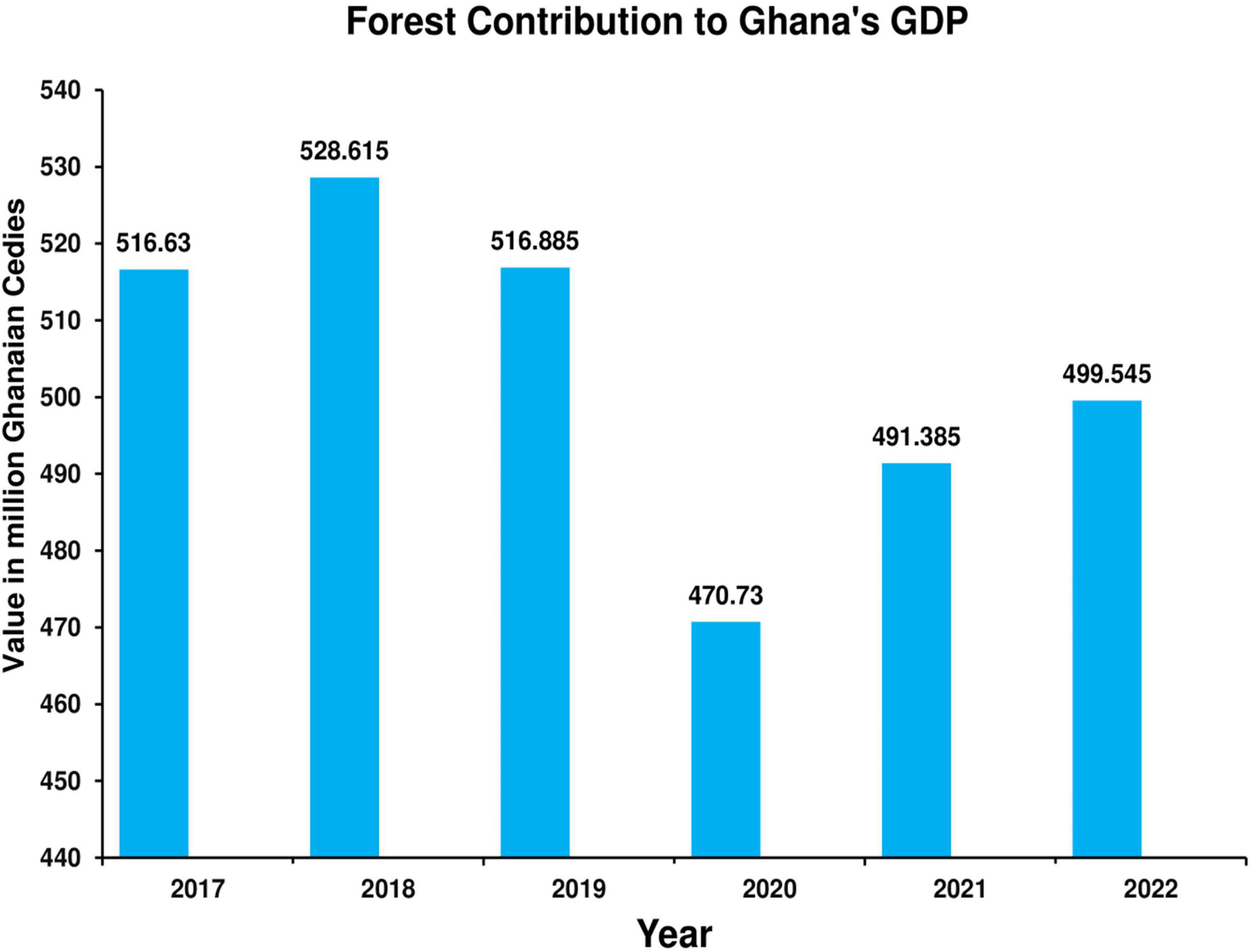
Figure 1. The study was conducted in the following locations: Ashanti Region in Ghana, Nkrabea Forest Reserve, and Tano Offin Reserve, and Afram East Headwaters.
2.2 Research design
The present study was conducted between November 2022 and February 2023. A mixed-method research design was used, involving both quantitative and qualitative approaches to provide an adequate and robust account of the effects of forest reserve management on the country’s economic gains and the livelihood outcomes of rural forest communities. The key effectiveness of a mixed-method approach is its ability to provide a more complete and robust understanding of a research problem, increasing the overall strength of the study compared to employing either a qualitative or a quantitative approach alone (Ortiz, 2007).
2.3 Sampling and interviews
Data were collected from staff of the Ghana Forestry Commission and residents of communities bordering three forest reserves. A purposive sampling method was used to select respondents based on their availability and willingness to participate (Gravetter and Forzano, 2012). This method was chosen to ensure a diverse representation of socio-economic and demographic characteristics such as gender, age, education level, occupation, and income. Two semi-structured questionnaires were designed to collect data from the different respondent groups.
2.4 Data collection
Data were collected using semi-structured questionnaires, with one questionnaire for the staff of the Ghana Forestry Commission and another for residents of communities bordering the three forest reserves. The questionnaire for the community was organized into six sections: Respondent’s Demographics, Forest Products and Utilization, Access to Forest Products and Services, Livelihood and Household Economy, Demographic Patterns Profile of the Study Area, and Forest Management. Three research assistants, fluent in local dialects, administered the questionnaires to community respondents. For livelihood indicators, a rating scale was used to evaluate the responses, assigning various weights to each indicator: 0.33 (low), 0.34–0.66 (Chena et al., 2013; Islam et al., 2014). Indicators measured on a binary scale (Yes/No) were computed as Yes (%) × 1 + No (%) × 0. Continuous scale indicators were categorized as “poor” (weight = 0.33) if below the mean value, and “medium” (weight = 0.66) if above the mean but less than 1.5 times the mean value.
2.5 Data analysis
The data collected were analyzed using both quantitative and qualitative methods to ensure a comprehensive understanding of the effects of forest reserve management on economic gains and rural livelihoods. Quantitative data were analyzed with SPSS version 25 and STATA version 15, employing descriptive statistics (means, frequencies, percentages) and inferential statistics (t-tests, chi-square tests) to summarize and identify significant differences in livelihood indicators and perceptions between 2017 and 2022. Livelihood indicators were rated on a scale, and binary and continuous scale indicators were appropriately categorized. Qualitative data from interviews were thematically analyzed to identify patterns related to forest management practices and their impacts. Results were presented in tables and figures, integrating both descriptive and thematic analyses to provide a holistic view of the study’s findings.
3 Results
3.1 Characteristics of the respondents
The demographic characteristics of the population are summarized in Table 1. The majority of the respondents in the present study were aged between 30 and 39 years, representing 41.88% of the population, followed by those aged between 20 and 29 years (22.22%). The least represented were those aged between 15 and 19 years (2.56%). Most respondents were males, comprising 58.97% of the total population interviewed. The majority were married (43.59%), followed by single individuals (33.33%), with divorced respondents being the least represented (7.69%). Regarding education, a significant portion had obtained secondary education (38.46%), followed by those with tertiary education (27.35%), and the least were those without formal education (16.24%). In terms of employment, the majority identified as entrepreneurs (40.17%), followed by those employed (28.21%). Seasonally employed individuals made up 13.68%, and retired respondents were the least represented (7.69%). The majority of respondents had household sizes ranging between 1 and 9 members (94.87%), with households of 3 to 6 members being the most common (43.30%), followed by those with 6–9 members (37.61%). Most respondents have been living in the area for 15 to 30 years (57.25%), while those who have been living there for a year or less were the least represented (5.98%). In the three forest reserves we surveyed, we found that the majority (82.05%) of the population live within 1 to 5 km of the forest.
3.2 Forest management status and regimes
The Forestry Commission of Ghana aimed to improve forest management and policy enforcement in the Ashanti Region in 2017 to address the unsustainable exploitation of forest resources, including deforestation and biodiversity loss. However, the results show that the effectiveness of this enhanced forest management from 2017 to 2022 was largely ineffective, with forest reserves often poorly managed and policies poorly enforced (Table 2). Regarding management regimes, it was found that the Ashanti Region’s forest management operates under a dual tenure system of state control and customary practices. The state controls 78% of the forests and claims ownership over all naturally occurring trees, even on customary land. Traditional authorities manage 11% of the forest, community land 6%, family and individual land 2%, and private land 1%. However, their effectiveness is undermined by the state’s control (Table 2). Challenges faced by Ghana’s forest management include insufficient funding, limited stakeholder participation, neglect of indigenous knowledge, and conflicts.
3.3 Forest products and utilization
Table 3 summarizes the forest products and their utilization by the communities from the three forest reserves. The communities utilize the forests for wood, grazing pastures for their livestock, growing crops on forestry farmland, collecting medicinal and aromatic herbs and plants, fruits, nuts, leaves, mushrooms, and for beekeeping. Among these uses, the collection of wood was by far the most important, with around 76.50% of the collected wood from the reserves being used for various purposes such as fuel wood, timber, poles for construction, and agriculture and animal husbandry (Table 3). Growing crops on forestry land was the second most important use, with 47.76% of the population relying on forest land for their farmland, and the expansion of their land encroaching on the forest land. Additionally, the collection of wild fruits, leaves, and mushrooms is an important utilization of the forest by the community, with at least 35.75% of the community depending on the forests for these products. Furthermore, 25.99% of the community mentioned that they depend on the forest for medicinal and aromatic herbs and plants. Another significant type of forest utilization is beekeeping, with a small portion (6.78%) of people stating that they depend on the forest for their beekeeping business.
3.4 Access to forest products and services
The rules and policies that govern the community’s access to forest products and services are summarized in Table 4. The rules and policies of Ghana stipulate that all trees in forests and on privately owned land belong to the government, giving it control over them. However, rural communities are granted full access to basic forest services and products, including grazing livestock, fuel wood, wood for poles, medicinal and aromatic herbs and plants, mushrooms, collected leaves, nuts, and beekeeping on forest land, all for free at any time. Harvesting wood is sometimes restricted to the collection of dead and dry trees. The harvesting or use of forest products that have a cash value or may be more destructive is strictly regulated by government agencies. To harvest timber, the community must obtain a license or permission from the Forestry Commission of Ghana.
3.5 Income from forest products and services
The main goal of Ghana’s community forestry policy is to conserve forests while allowing community access for subsistence purposes. If communities wish to engage in the harvesting of forestry resources, such as timber, for commercial purposes, they must obtain permission or a license from the Forestry Commission of Ghana. Nonetheless, some products can be harvested and sold without fees or restrictions. It should be noted that income generation may come from harvesting and selling forestry products such as mushrooms, fuel wood, fruits, grass, wood poles, and nuts. Indirect income from the forest includes the use of forest land for beekeeping and as pasture for livestock. When ranking these sources of income by importance and value, it was found that for direct sources of income, timber was perceived as the most important, followed by fuel wood and poles, then mushrooms, with nuts being the least important (Figure 2a). For indirect sources, using forest land as livestock pasture was deemed more important than beekeeping (Figure 2b).
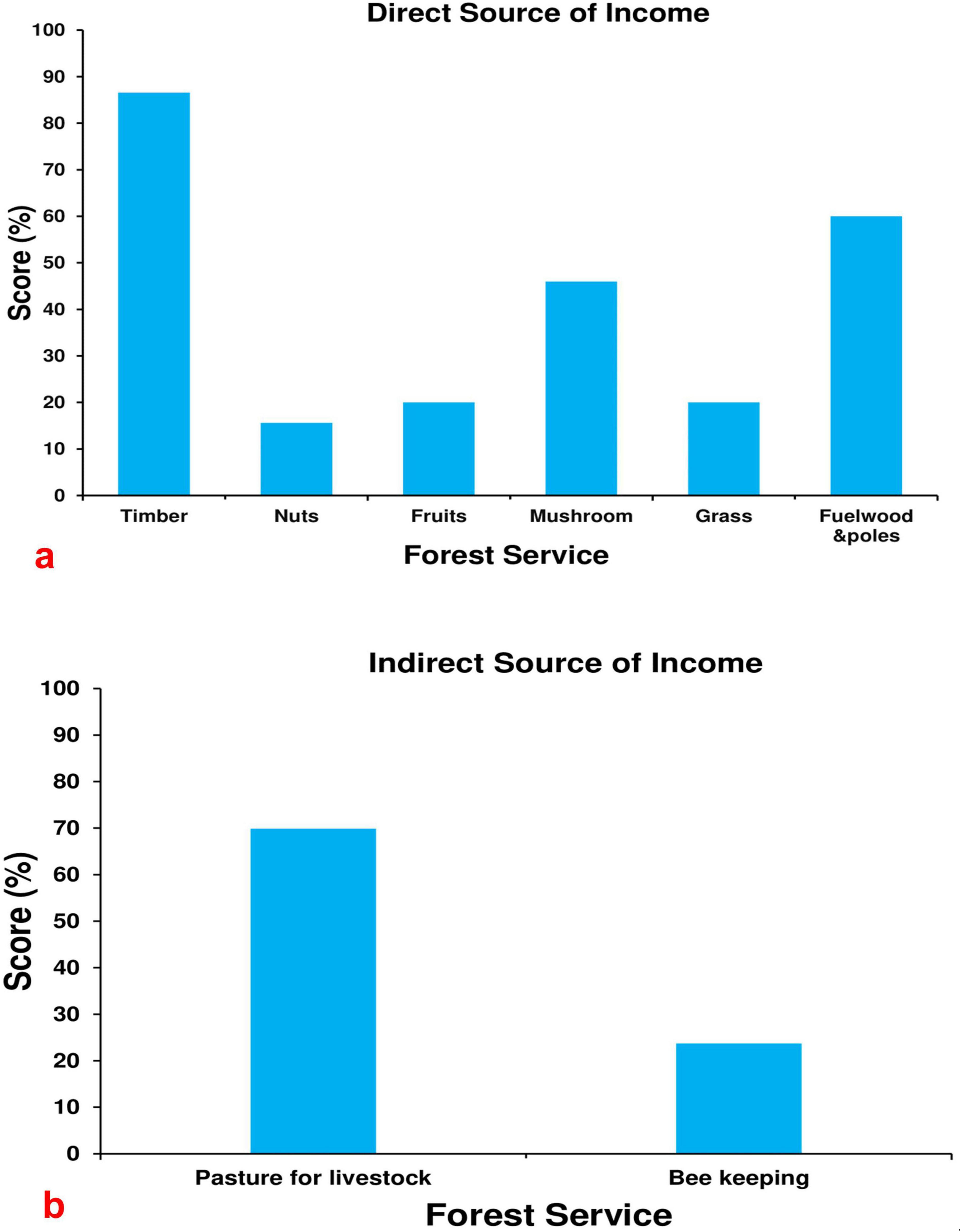
Figure 2. The figure shows the forest services that generate direct and indirect income based on survey responses. (a) Forest services that are direct sources of income. The scores reflect the percentage of respondents who identified the significance of each item: Timber (86.6%), Nuts (15.6%), Fruits (20%), Mushrooms (46%), Grass (20%), and Fuelwood & Poles (60%). (b) Forest services that are indirect sources of income. The scores represent the percentage of respondents who identified the significance of each item: Pasture for Livestock (69.9%) and Beekeeping (23.7%).
3.6 Changes in household status and livelihood
In the present study, the communities were asked to state the importance of the forests to their livelihoods and how much they depend on them (Figure 3). The majority of the people stated that the forest is very important (64.95%) and that they heavily depend on it (41%) for sustenance. To assess the influence of forest management on livelihoods, we surveyed key indicators of livelihood both now and as they were five years ago, based on the perception of the respondents. In the last five years, the management of the three reserves was primarily under the Forest Commission of Ghana, which was applying government policies accordingly. The results regarding the influence of management on livelihoods are presented in Table 2. The household results showed both positive and negative changes in the livelihood indicators. In 2017, the estimated index value for each livelihood indicator ranged from 0.33 to 0.78, while in 2022, the indicators ranged from 0.48 to 0.71. All indicators, including household finances, food security, physical indicators, and social indicators, showed significant (p < 0.05) improvement from 2017 to 2022. However, the natural indicator showed a significant (p > 0.05) decline in 2022 compared to 2017, indicating a significant (p < 0.05) decrease in forest cover.
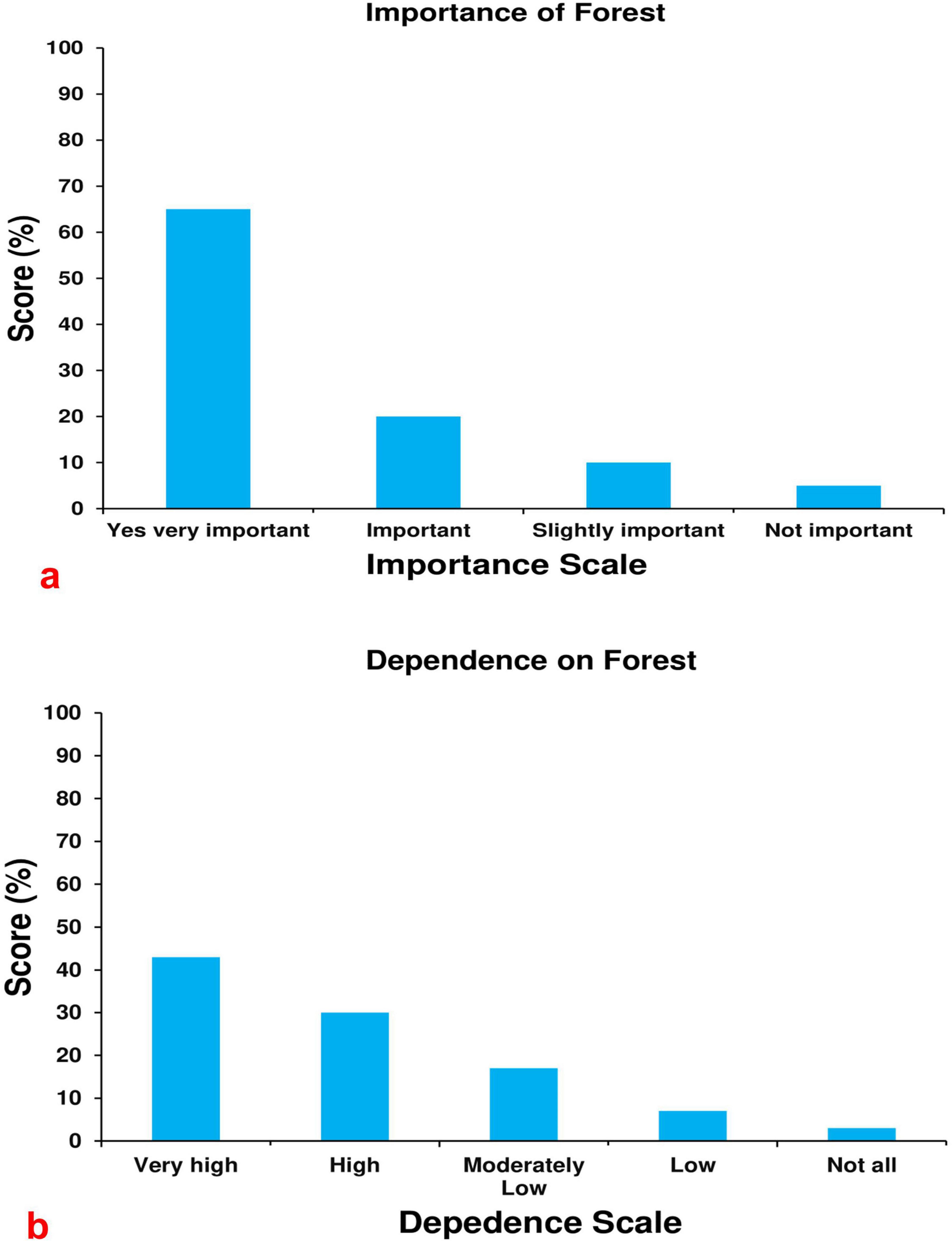
Figure 3. The figure shows the perceived importance and dependence of the community on the forest and forest services based on the survey. (a) The perceived importance of various forest and forest services. The scores reflect the percentage of respondents who rated each service on a scale of importance, with ‘very important’ receiving 65%, ‘Important’ 20%, ‘Slightly important’ 10%, and ‘Not important’ 5%. (b) The perceived dependence of the community on forest and forest services. Scores represent the percentage of respondents indicating their level of dependence: Very High (43%), High (30%), Moderate (17%), Low (7%), and Not at All (3%).
3.7 Demographic patterns profile of the study area
To understand how management has influenced forest cover and subsequently affected livelihoods, we evaluated the demographic patterns in the study area. Firstly, we assessed the pattern of population change over the past 5 years (2017 to 2022). The results showed an insignificant increase in the population, which was inversely related to forest cover change (natural indicator), indicating a significant reduction in forest cover (Table 2). It was observed that people were migrating from the study area to urban areas. The major reasons for migration included education (45%), employment (35%), business (15%), and other reasons (5%) (Figure 3a). The patterns of migration showed that the majority of people migrating were aged between 15 and 20 years (45%), followed by those between 20 and 29 years (30%), with the least being those above 40 years. In terms of gender, it was observed that more males were migrating from rural areas than females. However, the difference between males and females aged between 15 and 20 years was not significant, whereas it was more pronounced for those above 40 years.
3.8 Perception and attitude towards forest resources management and conservation
To further understand the influence of forest resource management in the Ashanti region, we evaluated the respondents’ perception of the management and conservation rules and policies in 2017 and 2022 based on several indicators, as shown in Table 5. To ensure unbiased results, we collected information separately for each year (2017 and 2022). Respondents’ knowledge of forest management and use was slightly above average in 2017 (57%), which increased to 59.68% in 2022. This was reflected in the responses, where the majority of the respondents in 2017 said the rules and policies about forest use and management were not clear (82.01%), but this did change when we compared 2017 to 2022. Furthermore, the community stated that the rules and policies do not consider their interests and needs, and this perception did not change between 2017 and 2022. In terms of access to resources, half of the community in 2017 felt that it was not easy, and this did not change in 2022. They also raised concerns that forest managers were not following the rules, a trend similar in 2017 (58.9%) and 2022 (60%). The community lamented that forest managers were corrupt. They expressed dissatisfaction with the current forestry management arrangements and desired more involvement in the process, with interest in involvement increasing from 78% in 2017 to 80% in 2022.
3.9 Forestry and economic growth of the Ashanti region
The Ashanti region’s forestry resources were evaluated from 2017 to 2022 (Figure 4). In 2018, the contribution of forestry resources to the Ashanti region’s economy increased from 516.6 million Ghanaian cedis in 2017 to 528.6 million cedis. However, the contribution of Ghana’s logging and forestry sector to the nation’s GDP showed a decline in 2020. The sector contributed approximately 470.7 million cedis (30.4 million US dollars) to the GDP in 2020, down from almost 516.9 million cedis (33.37 million US dollars) in 2019. The highest contribution during the observed period was in 2018, but it has been declining since, reaching its lowest in 2020 at 470.7 million cedis. This data indicates a downward trend in the contribution of forestry resources to the GDP.
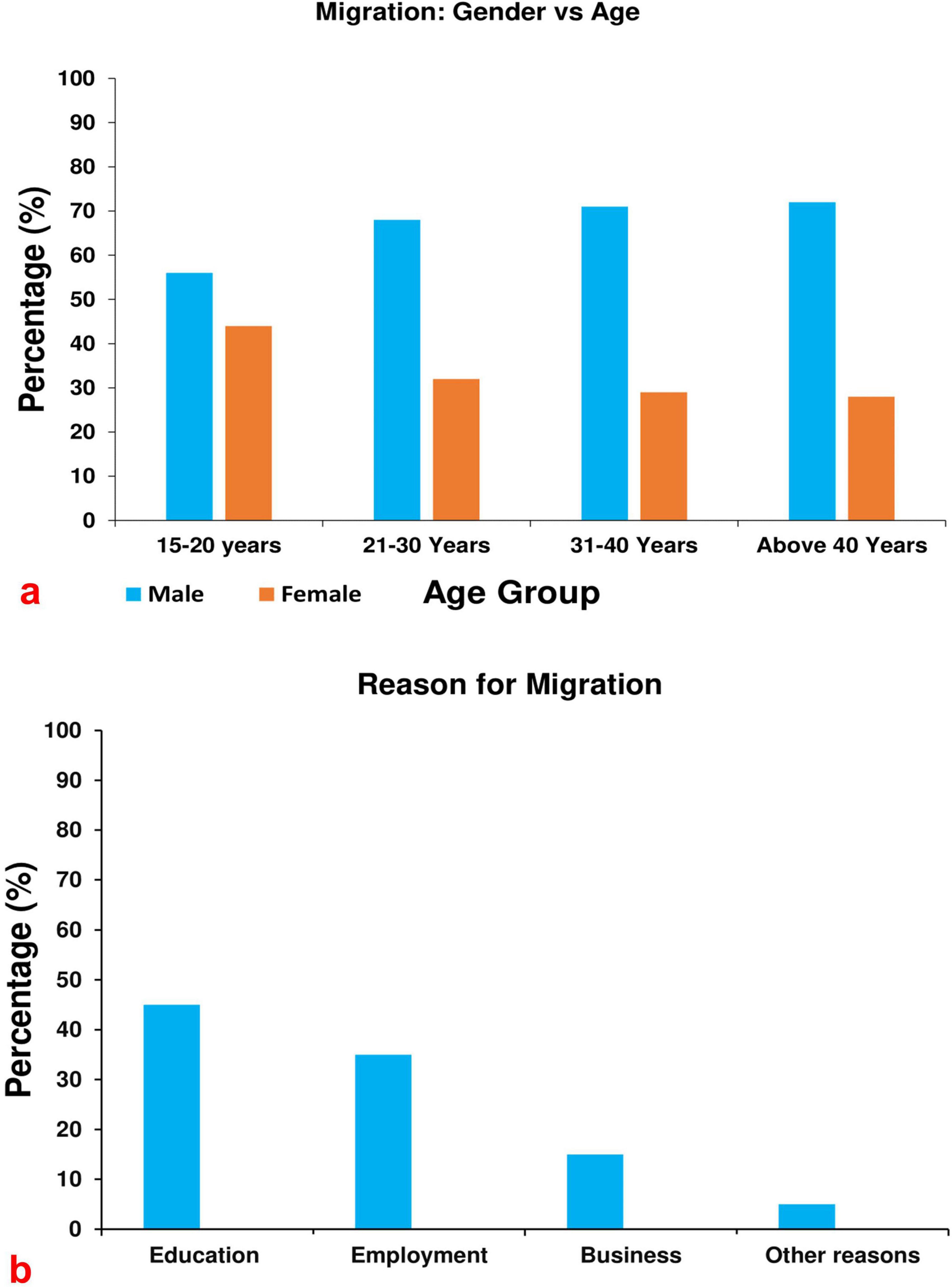
Figure 4. The figure illustrates the patterns and reasons of migration from the study area based on survey responses. (a) Shows the migration patterns from the study area, segmented by gender and age group. The data shows the percentage of males and females who migrated in each age group. (b) Reasons for Migration from the Study Area. The percentages indicate the proportion of respondents citing each reason: Education (45%), Employment (35%), Business (15%), and Other Reasons (5%).
4 Discussion
4.1 Access to forest products and services
Forest resources are essential for the survival and economic development of rural communities, providing a wide range of products and services crucial for daily life and economic growth (Cheng et al., 2017; Gumoshabe et al., 2023; Vedeld et al., 2007). These resources include wood for construction and fuel, grazing areas for livestock, medicinal plants, and various non-timber forest products like mushrooms and nuts (Gumoshabe et al., 2023; Kazungu et al., 2020). Access to these resources is vital, as demonstrated by studies in Zambia, Uganda, Kenya, and other countries, where communities depend on them for income generation and daily needs (Cheng et al., 2017; Gumoshabe et al., 2023; Vedeld et al., 2007). In the present study, it was found that communities living near the three forest reserves have unrestricted access to basic forest resources such as wood for poles, fuelwood, grazing areas, collections of medicinal and aromatic plants, mushrooms, leaves, nuts, and free beekeeping on forest land at any time. However, to minimize the impact on live forest ecosystems, harvesting is sometimes restricted to dead or dry trees. The harvesting of high-value or ecologically sensitive products is restricted, and the Forestry Commission issues licenses and permissions to communities for timber harvesting, prioritizing sustainable practices. These regulations are crucial for maintaining ecosystem health and biodiversity, preventing habitat degradation, loss of biodiversity, or disruption of ecosystem services. Sustainable management of forest resources ensures that communities can continue to rely on these resources without compromising the long-term health of the forest ecosystem (Tugume et al., 2015). The sustainable management of forest resources is critical to maintaining ecosystem health and biodiversity. Regulations often prohibit the harvesting of high-value or ecologically sensitive products without proper authorization to prevent environmental degradation and ensure long-term sustainability (Ghazali et al., 2022; Tugume et al., 2015). In some cases, community-based management approaches empower residents to participate in decision-making processes regarding resource use, fostering both conservation efforts and socio-economic development (Ghazali et al., 2022).
4.2 Household status and livelihood
Globally, forests are essential for maintaining people’s livelihoods, especially for the poor who depend on them for their daily needs (Cheng et al., 2017; Oldekop et al., 2020; Wunder et al., 2014). An effective forest management strategy can help drive economic growth by generating revenue, jobs, food security, and housing where it is most desperately needed (Cheng et al., 2017; Kożuch and Marzȩda, 2021). In this study, the results showed that indicators including household finances, food security, physical indicators, and social indicators showed a significant improvement (p < 0.05) in 2022 compared to 2017 (Table 2). The benefits to livelihoods were realized through the harvesting and selling of forestry products such as mushrooms, fuelwood, fruits, grass, wood poles, and nuts. Additionally, indirect income from the forest included the use of forest land for beekeeping and pasture for livestock. However, the household survey indicated that during this period, forestry management was not very effective, with forest reserves often poorly managed and policies poorly enforced. Thus, the relationship between livelihood and management is difficult to quantify, and more studies may be needed to unveil this. The rise in livelihood could be associated with the decline in forest cover (natural indicator). In the present study, it was observed that the natural indicator showed a significant decline in 2022 compared to 2017 (p > 0.05). Poor forest management can have damaging impacts on species, water quality, and even residents (Kożuch and Marzȩda, 2021; Petermann et al., 2016). At the same time, residents and others may take advantage of the situation and unsustainably use the resources. This could be the case in the present study, where an improvement in livelihood occurred while forest cover was reduced. To reduce poverty and promote national economic growth, understanding the relationship between natural forest management and livelihoods is crucial (Fisher, 2004; Gumoshabe et al., 2023; Muthee et al., 2022; Wunder et al., 2014). According to reports, forest income helps to lessen household income inequality (Byakagaba et al., 2019).
4.3 Demographic patterns profile of the study area
Forest-reliant communities are experiencing an unprecedented exodus, predominantly of working-aged men (Hecht et al., 2015; Oldekop et al., 2020). In the present study, it was observed that the majority of the people migrating were those aged between 15 and 20 (45%), followed by those between 20 and 29 (30), and the least were those who are above 40 years. The livelihoods of forest communities are impacted by shifting demographic trends, as are the macro-governance organizations that will eventually reshape forested landscapes in both social and environmental aspects. For instance, migration from rural communities into urban areas caused reforestation in Nepal (Oldekop et al., 2020), changes in community forest management institutions in Mexico (Robson and Berkes, 2011), and a transition from subsistence to commodity crop monocultures in the agricultural systems of the Philippines (Montefrio et al., 2014).
Over the last two decades, logging, agricultural expansion, development, and other human activities have led to the deforestation of more than 120,000 square kilometers per year (Meyerson, 2004; Gatarić et al., 2022). This continues a historical process that has resulted in the loss of less than half of the world’s original forests (Meyerson, 2004; Lewis, 2006; Muthee et al., 2022). Although population growth and density are indisputably connected to forest cover trends, there is no simple way to describe or predict that association (Frederick and Meyerson, 2004). In the present evaluation of the demographic pattern of the study area, the results showed an insignificant increase in population, yet a significant loss of forest cover (natural indicator) was observed (Table 2). The migration from the study area to urban areas was driven by several factors: education (45%), employment (35%), business (15%), and other reasons (5%). This migration has various impacts on both the rural areas and the urban destinations (Figure 3a), resulting in a relatively stable and slightly increasing population over five years. The observed forest cover loss without a significant population increase can be explained by generalizations from deforestation studies. It is possible to keep large areas of forest intact at extremely low populations in areas where the population can be sustained primarily through the harvesting of non-timber forest products rather than agriculture (Jimoh et al., 2013; Kainyande et al., 2022). However, even in sparsely populated areas, external forces such as demand for timber or cattle in other parts of the country or world can cause deforestation unrelated to local population growth. Respondents stated that forests are very important for their livestock and farming; thus, the change in forest cover might be caused by an increase in livestock. This demand could originate from cities and towns where there are large markets, driving communities to produce forest-related products (Crook et al., 2015).
4.4 Perception and attitude towards forest resources management and conservation
Forest communities are essential to the preservation of forest resources. To achieve conservation objectives and lessen conflicts over the use of forest resources, it is important to understand how communities use, feel about, and perceive forests and management practices (Wei et al., 2012; Yamada, 2018; Muttaqin et al., 2019). In the present study, we found that respondents’ knowledge about forest management and use was slightly above average in 2017, with a score of 57%. This knowledge increased to 59.68% by 2022. In the present study, we found that respondents’ knowledge about forest management and use was slightly above average in 2017, with a score of 57%. This knowledge increased to 59.68% by 2022. Despite this improvement, the majority of respondents (82.01%) stated that the rules and policies regarding forest use and management were unclear. This perception did not change significantly when comparing the data from 2017 to 2022 (Table 5). This indicates a persistent issue with knowledge of the policies and sensitization of the communities regarding the policies. The government and other stakeholders are not doing enough to educate the communities about the rules and their importance. Continuous sensitization is crucial in improving communities’ knowledge of the advantages and benefits that they could contribute significantly to the conservation of forest resources (Harbi et al., 2018; Derkyi et al., 2021).
Furthermore, the community stated that the rules and policies do consider their interests and needs, and this perception did not change between 2017 and 2023. Although the communities are permitted to harvest from the natural forest at a subsistence level, it was found that the management of all forest resources, including timber harvesting rights, is administered by the Forestry Commission (The Government) for the benefit of the landowners (Amoah and Korle, 2020; Nicholas et al., 2023). This policy leaves the communities around the three forest reserves excluded and not given a chance to participate in the management of resources. The majority of the respondents felt that it would be beneficial if they were involved in the management process of resources, with interest increasing from 78% in 2017 to 80% in 2023 (Table 5). Therefore, the government needs to introduce a form of management that involves local communities. Community-based forestry management can contribute to national economic growth, sustainable forest management, and climate change mitigation. It can also preserve and improve natural capital, develop social, institutional, human, and financial capital, improve livelihoods, and reduce poverty and inequality (Table 5). This is because they feel they are the rightful owners of the forest and are responsible for preserving the resources.
Corruption and misconduct of forest managers have often been blamed for causing deforestation and conflicts between forest users; however, the evidence is mixed. In the present study, respondents raised concerns that forest managers were not following rules, a trend similar to in 2017 (58.9%) and 2023 (60%). The community lamented that forest managers were corrupt. Higher levels of corruption have also been linked to higher rates of forest conversion to agricultural land throughout Latin America (Bulte et al., 2007). Similarly, Smith et al. (2003) discovered in a groundbreaking study that corruption impacted the overall amount of forest loss, but not the loss of natural forests, although those conclusions were later disproved. Corruption has been attributed to unequal, unfair, and illegal distribution and issuance of permits for forest product harvesting (Acheampong and Maryudi, 2020; Gangi et al., 2023).
4.5 Forestry and economic growth of the Ashanti region
Forests offer numerous social and economic advantages to humanity (Addas, 2023; Konijnendijk, 2023). These include investments in the forest industry as well as contributions to the overall economy, such as job creation, energy production, processing, and trade, among other things (Li et al., 2019; Addas, 2023). Additionally, forests play a role in the preservation and management of locations and environments of significant cultural, spiritual, or recreational importance (Bernbaum, 2018). In Ghana, forestry resources contribute approximately 6.3% to GDP and provide livelihoods for about 15% (3.6 million) of the Ghanaian population. In the present study, we evaluated the contribution of Ghanaian forestry resources from 2017 to 2022 (Figure 4). The results indicated a significant contribution to the region’s and the national GDP. For example, in 2018, the contribution of the Ashanti region’s forest and forest resources was 516.6 million Ghanaian cedis. This value comes from over 50 products that are extracted from both humid forests and savannah woodlands across the country (Reserves in the Ashanti region). The most commonly exploited goods for both commercial and subsistence use are fuelwood, construction materials (timber, poles, rattan, bamboo), medicines, and wild edibles (mostly game meat, fruits, nuts, mushrooms, and snails) (Table 4). In addition to directly supporting about two million people, the forestry sector (natural forests and plantations) employs over 75,000 workers. By the end of the third quarter of 2015, timber produced 135 million euros in foreign exchange earnings (Beatrice et al., 2017). Despite this important contribution to Ghana’s economy, in the present study, we observed that since 2018 the contribution of forestry to Ghana’s GDP has been declining, moving from 516.6 million Ghanaian cedis in 2018 to 516.9 million Ghanaian cedis in 2020 (Figure 5). This decline could be attributed to several factors. One factor unveiled in the present study is the decline in forest cover; the natural indicators based on forest cover showed a decline over the past 5 years (Table 2). Additionally, a study conducted by Maraseni et al. (2022) on the impact of COVID-19 on the forestry sector in the lowland region of Nepal showed a decline in forest-related products such as timber and their contribution to the national GDP. Thus, the decline in Ghana could also be attributed to the impact of COVID-19. However, management needs to develop strategies to reduce the loss of forest cover while optimizing the benefits of the forests.
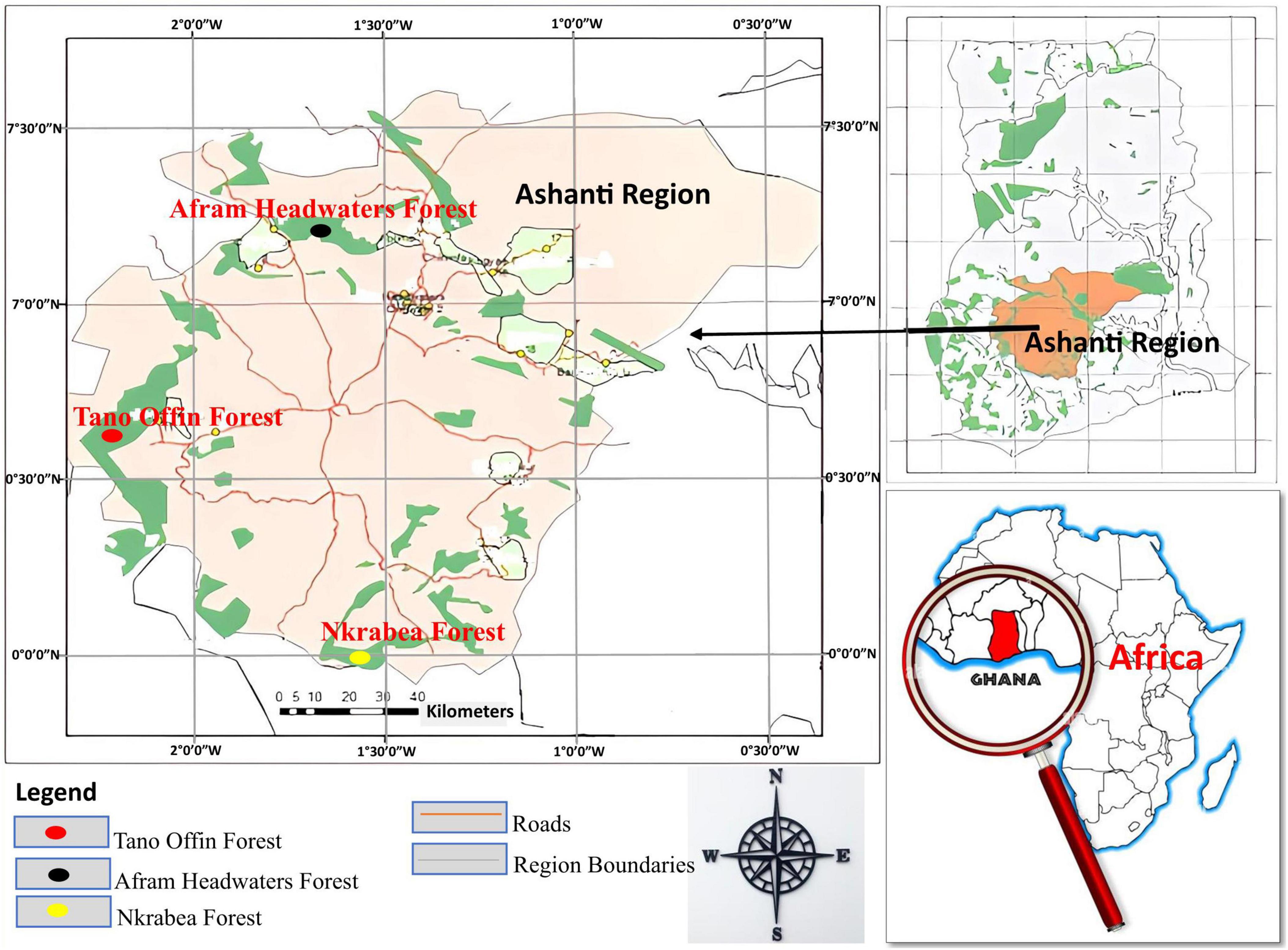
Figure 5. The annual contribution of the forest sector in the Ashanti Region to Ghana’s economy over a five-year period. The values, represented in million Ghanaian cedis, show the following contributions: 516.63 million in 2017, 528.615 million in 2018, 516.885 million in 2019, 470.73 million in 2020, 491.385 million in 2021, and 499.545 million in 2022.
4.5 The influence of management on economic development, livelihoods, and biodiversity conservation
The performance of forest management in the Ashanti Region, Ghana, from 2017 to 2022 reveals significant challenges and varying impacts on economic development, livelihoods, and biodiversity conservation (Table 2). Despite efforts by the Forestry Commission of Ghana to enhance forest management and policy enforcement, the effectiveness of these measures has been largely inadequate. Forest reserves have often been poorly managed, and policies have been inconsistently enforced, which has led to ongoing issues such as deforestation and degradation of forest cover (Table 2). Examining the link between forest management and economic development, it becomes apparent that although the forestry sector significantly contributes to the region’s and national GDP, there has been a notable decline in its economic contribution. The value generated from forestry resources decreased from 2.073 billion Ghanaian cedis in 2018 to 1.85 billion Ghanaian cedis in 2020. This decline can be partly attributed to ineffective forest management, which has resulted in diminished forest resources and, consequently, reduced economic benefits, this is similar to several other studies (Hein and Van Ierland, 2006; The Ecological Management, 2024; Martire et al., 2015). Proper management could reverse this trend by ensuring sustainable resource use, thereby boosting the economic contributions of the forestry sector (The Ecological Management, 2024). In terms of livelihoods, forest resources are crucial for the local communities who rely on them for subsistence and income (Gumoshabe et al., 2023; Muthee et al., 2022; Vedeld et al., 2007). The study shows that while there have been improvements in certain livelihood indicators, such as food security and physical well-being, the correlation with forest management is complex. The forest management was poor and inefficient; however, the livelihoods and food security of the communities were improved (Table 5). Ineffective management has led to unsustainable harvesting practices that threaten the long-term availability of forest resources (Damette and Delacote, 2011). This put at risk the livelihoods of communities that depend on them, despite short-term gains. Biodiversity conservation has also been adversely affected by the current state of forest management. The decline in forest cover, as indicated by the natural indicators, signifies a loss in biodiversity, which is exacerbated by inadequate management and enforcement of conservation policies (Damette and Delacote, 2011; Harbi et al., 2018). The preservation of biodiversity requires robust management practices that include monitoring, enforcement, and community involvement.
5 Conclusion
The study investigated the influence of forest management in the Ashanti region of Ghana on the country’s economic gain, the livelihood of rural communities, and the mitigation of forest degradation. The results suggest a significant positive increase in livelihood based on four indicators: household finances, food security, physical indicators, and social indicators. Despite the livelihood improvement, it was observed that forest cover had significantly decreased in recent years. Although issues surrounding the sustainable use of forest resources are complex, the present decline in forest cover around the three forest reserves in the Ashanti region of Ghana was attributed to poor management. The communities indicated there is poor management and poor enforcement of forest policies. The community stated that forest managers were not following rules; this trend was similar in 2017 (58.9%) and in 2023 (60%). The community lamented that forest managers were corrupt. At the same time, the communities said they do not understand forest policy regarding the utilization of forest resources, highlighting the need for capacity building and sensitization to ensure the communities understand the policies and the importance of conserving forest resources. The community expressed dissatisfaction with the current forestry management arrangement and desired to be involved in the management process. Thus, the government should introduce community-based forestry management to ensure that the community participates more in the management of their resources.
Data availability statement
The original contributions presented in the study are included in the article/Supplementary material, further inquiries can be directed to the corresponding author.
Ethics statement
Written informed consent was obtained from the individual(s) for the publication of any potentially identifiable images or data included in this article.
Author contributions
PA: Conceptualization, Data curation, Formal analysis, Investigation, Methodology, Visualization, Writing – original draft, Writing – review and editing, Funding acquisition, Project administration, Resources, Software, Supervision, Validation. JY: Conceptualization, Data curation, Formal analysis, Funding acquisition, Methodology, Project administration, Resources, Software, Supervision, Visualization, Writing – original draft, Writing – review and editing.
Funding
The author(s) declare financial support was received for the research, authorship, and/or publication of the article. This work was supported by grants from the Key Project of the National Social Science Foundation of China (Grant No. 20&ZD092).
Conflict of interest
The authors declare that the research was conducted in the absence of any commercial or financial relationships that could be construed as a potential conflict of interest.
Publisher’s note
All claims expressed in this article are solely those of the authors and do not necessarily represent those of their affiliated organizations, or those of the publisher, the editors and the reviewers. Any product that may be evaluated in this article, or claim that may be made by its manufacturer, is not guaranteed or endorsed by the publisher.
Supplementary material
The Supplementary Material for this article can be found online at: https://www.frontiersin.org/articles/10.3389/ffgc.2024.1366615/full#supplementary-material
References
Acheampong, E. O., Agyeman, K. O., and Amponsah, O. (2018). The motivation for community participation in forest management on JSTOR. Int. For. Rev. 20, 1–17.
Acheampong, E., and Maryudi, A. (2020). Avoiding legality: Timber producers’ strategies and motivations under FLEGT in Ghana and Indonesia. Forest Policy Econ. 111:102047. doi: 10.1016/J.FORPOL.2019.102047
Addas, A. (2023). Impact of forestry on environment and human health: An evidence-based investigation. Front. Public Health 11:1260519. doi: 10.3389/FPUBH.2023.1260519
Agrawal, A., Cashore, B., Hardin, R., Shepherd, G., Benson, C., and Miller, D. (2013). Economic contributions of forests. New York, NA: United Nations.
Amiraslani, F., and Dragovich, D. (2013). Forest management policies and oil wealth in Iran over the last century: A review. Nat. Resourc. Forum 37, 167–176. doi: 10.1111/1477-8947.12016
Amoah, A., and Korle, K. (2020). Forest depletion in Ghana: The empirical evidence and associated driver intensities. For. Econ. Rev. 2, 61–80. doi: 10.1108/FER-12-2019-0020
Ankomah, F., Kyereh, B., Ansong, M., and Asante, W. (2020). Forest management regimes and drivers of forest cover loss in forest reserves in the high forest zone of Ghana. Int. J. For. Res. 2020:8865936. doi: 10.1155/2020/8865936
Bayrak, M. M., and Marafa, L. M. (2016). Ten years of REDD+: A critical review of the impact of REDD+ on forest-dependent communities. Sustainability 8, 1–22. doi: 10.3390/su8070620
Beatrice, K. A., Oduro, E., and Nutakor, S. P. (2017). Public and private sector development on forest products industry in Ghana. Nairobi: African Forest Forum.
Bernbaum, E. (2018). “The cultural and spiritual significance of nature: Involving the general public in the management and governance of protected areas” in Cultural and spiritual significance of nature in protected and conserved areas: Governance, Management and Policy. Routledge.
Bulte, E. H., Damania, R., and López, R. (2007). On the gains of committing to inefficiency: Corruption, deforestation and low land productivity in Latin America. J. Environ. Econ. Manag. 54, 277–295. doi: 10.1016/J.JEEM.2007.05.002
Byakagaba, P., Mugagga, F., and Nnakayima, D. (2019). The socio-economic and environmental implications of oil and gas exploration: Perspectives at the micro level in the Albertine region of Uganda. Extract. Ind. Soc. 6, 358–366. doi: 10.1016/j.exis.2019.01.006
Chena, H., Zhu, T., Krotta, M., Calvo, J. F., Ganesh, S. P., and Makot, I. (2013). Measurement and evaluation of livelihood assets in sustainable forest commons governance. Land Use Policy 30, 908–914. doi: 10.1016/J.LANDUSEPOL.2012.06.009
Cheng, S. H., Ahlroth, S., Onder, S., Shyamsundar, P., Garside, R., Kristjanson, P., et al. (2017). What is the evidence for the contribution of forests to poverty alleviation? A systematic map protocol. Environ. Evid. 6, 1–11. doi: 10.1186/S13750-017-0088-9/TABLES/4
Crook, D. A., Lowe, W. H., Allendorf, F. W., Erűs, T., Finn, D. S., Gillanders, B. M., et al. (2015). Human effects on ecological connectivity in aquatic ecosystems: Integrating scientific approaches to support management and mitigation. Sci. Total Environ. 534, 52–64. doi: 10.1016/j.scitotenv.2015.04.034
Damette, O., and Delacote, P. (2011). Unsustainable timber harvesting, deforestation and the role of certi fi cation. Ecol. Econ. 70, 1211–1219. doi: 10.1016/j.ecolecon.2011.01.025
Derkyi, M. A. A., Appau, Y., and Boakye Boadu, K. (2021). Factors influencing community participation in the implementation and monitoring of FLEGT-VPA in Ghana. For. Econ. Rev. 3, 19–37. doi: 10.1108/FER-07-2020-0010
FAO (2022). The state of the world’s forests 2022: Forest pathways for green recovery and building inclusive, resilient, and sustainable economies. Rome: FAO.
Fisher, M. (2004). Household welfare and forest dependence in Southern Malawi. Environ. Dev. Econ. 9, 135–154. doi: 10.1017/S1355770X03001219
Frederick, A. B., and Meyerson, F. (2004). Population growth and deforestation: A critical and complex relationship. Washington, DC: Population Reference Bureau. Available online at: https://www.prb.org/Publications/Articles/2004/PopulationGrowthandDeforestationACriticalandComplexRelationship.aspx
Gangi, F., Daniele, L. M., Tani, M., and Papaluca, O. (2023). Drivers and impacts of green product innovation as open innovation: Evidence from science-based firms. Bus. Ethics Environ. Responsibil. 32, 187–204. doi: 10.1111/BEER.12583
Gatarić, D., Ðerc̆an, B., Živković, M. B., Ostojić, M., Manojlović, S., Sibinović, M., et al. (2022). Can depopulation stop deforestation? The impact of demographic movement on forest cover changes in the settlements of the south Banat district (Serbia). Front. Environ. Sci. 10:897201. doi: 10.3389/FENVS.2022.897201/BIBTEX
Ghana Statistics Service. (2022). Contribution of the forestry and logging industry to GDP in Ghana from. Accra: Ghana Statistic.
Ghazali, S., Zibaei, M., and Keshavarz, M. (2022). The effectiveness of livelihood management strategies in mitigating drought impacts and improving livability of pastoralist households. IJDRR 77:103063. doi: 10.1016/J.IJDRR.2022.103063
Global Forest Watch, (2024). Ghana deforestation rates & statistics: GFW. Forest monitoring, land use & deforestation trends. Available online at: https://www.globalforestwatch.org/dashboards/country/GHA/?map=eyJjYW5Cb3VuZCI6dHJ1ZX0%3D (accessed January 2, 2024).
Gravetter, F. J., and Forzano, L. A. B. (2012). Research methods for the behavioral sciences. Belmont, NT: Wadsworth, Cengage Learning.
Gumoshabe, M., Anywar, G., and Tugume, P. (2023). Access to provisioning services by local communities from Mpanga central forest reserve in central Uganda. Front. Forests Glob. Change 6:1021664. doi: 10.3389/FFGC.2023.1021664/BIBTEX
Harbi, J., Erbaugh, J. T., Sidiq, M., Haasler, B., and Nurrochmat, D. R. (2018). Making a bridge between livelihoods and forest conservation: Lessons from non timber forest products’ utilization in South Sumatera, Indonesia. Forest Policy Econ. 94, 1–10. doi: 10.1016/J.FORPOL.2018.05.011
Hecht, S., Yang, A. L., Bimbika Sijapati Basnett, C. P., and Peluso, N. L. (2015). People in motion, forests in transition: Trends in migration, urbanization, and remittances and their effects on tropical forests. Bogor: Center for International Forestry Research [CIFOR].
Hein, L., and Van Ierland, E. (2006). Efficient and sustainable management of complex forest ecosystems. Ecol. Model. 190, 351–366. doi: 10.1016/j.ecolmodel.2005.04.029
Hoeinghaus, D. J., Agostinho, A. A., Gomes, L. C., Pelicice, F. M., Okada, E. K., Latini, J. D., et al. (2009). Effects of river impoundment on ecosystem services of large tropical rivers: Embodied energy and market value of artisanal fisheries. Conserv. Biol. 23, 1222–1231. doi: 10.1111/j.1523-1739.2009.01248.x
Islam, K. K., Kimihiko, H., Tani, M., Krott, M., Sato, N., Islam, K. K., et al. (2014). Actors’ power, livelihood assets and participatory forestry in Bangladesh: Evidence from the Sal forests area. Open J. For. 4, 1–9. doi: 10.4236/OJF.2014.45B001
Jimoh, S. O., Amusa, T. O., and Azeez, I. O. (2013). Population distribution and threats to sustainable management of selected non-timber forest products in tropical lowland rainforests of south western Nigeria. J. For. Res. 24, 75–82. doi: 10.1007/s11676-013-0327-z
Kainyande, A., Auch, E. F., and Okoni-Williams, A. D. (2022). The socio-economic contributions of large-scale plantation forests: Perceptions of adjacent rural communities in the Northern Province of Sierra Leone. Trees Forests People 10:100329. doi: 10.1016/J.TFP.2022.100329
Kaplan, J. O., Krumhardt, K. M., and Zimmermann, N. (2009). The prehistoric and preindustrial deforestation of Europe. Quatern. Sci. Rev. 28, 3016–3034. doi: 10.1016/J.QUASCIREV.2009.09.028
Kaur, L., and Mittal, R. (2020). Forest conservation for livelihood security. Ind. Assoc. Adv. Sci. Technol. 11:61. doi: 10.15515/iaast.0976-4828.11.4.6167
Kazungu, M., Zhunusova, E., Yang, A. L., Kabwe, G., Gumbo, D. J., and Günter, S. (2020). Forest use strategies and their determinants among rural households in the Miombo woodlands of the Copperbelt Province, Zambia. Forest Policy Econ. 111:102078. doi: 10.1016/j.forpol.2019.102078
Konijnendijk, C. C. (2023). Evidence-based guidelines for greener, healthier, more resilient neighbourhoods: Introducing the 3–30–300 rule. J. For. Res. 34, 821–830. doi: 10.1007/S11676-022-01523-Z/FIGURES/1
Kożuch, A., and Marzȩda, A. (2021). The effects of natural and economic factors on the financial performance of forest management units: The example of forest districts of the state forests national forest holding from eastern Poland. Forests 12:1559. doi: 10.3390/f12111559
Lewis, S. L. (2006). Tropical forests and the changing earth system. Philos. Trans. R. Soc. B Biol. Sci. 361, 195–210. doi: 10.1098/rstb.2005.1711
Li, Y., Mei, B., and Linhares-Juvenal, T. (2019). The economic contribution of the world’s forest sector. Forest Policy Econ. 100, 236–253. doi: 10.1016/J.FORPOL.2019.01.004
Maraseni, T., Poudyal, B. H., Aryal, K., and Laudari, H. K. (2022). Impact of COVID-19 in the forestry sector: A case of lowland region of Nepal. Land Use Policy 120:106280. doi: 10.1016/J.LANDUSEPOL.2022.106280
Martire, S., Castellani, V., and Sala, S. (2015). Resources, conservation and recycling carrying capacity assessment of forest resources: Enhancing environmental sustainability in energy production at local scale. Resourc. Conserv. Recycl. 94, 11–20. doi: 10.1016/j.resconrec.2014.11.002
Meyerson, F. A. B. (2004). Policy view: Immigration, population policy, and the sierra club. Popul. Environ. 26, 61–69. doi: 10.1023/B:POEN.0000039953.06713.0C/METRICS
Montefrio, M. J. F., Ortiga, Y. Y., and Josol, M. R. C. B. (2014). Inducing development: Social remittances and the expansion of oil palm. Int. Migr. Rev. 48, 216–242. doi: 10.1111/IMRE.12075
Muthee, K., Duguma, L., Wainaina, P., Minang, P., and Nzyoka, J. (2022). A review of global policy mechanisms designed for tropical forests conservation and climate risks management. Front. Forests Glob. Change 4:748170. doi: 10.3389/FFGC.2021.748170/BIBTEX
Muttaqin, M. Z., Alviya, I., Lugina, M., Hamdani, F. A. U., and Indartik. (2019). Developing community-based forest ecosystem service management to reduce emissions from deforestation and forest degradation. Forest Policy Econ. 108:101938. doi: 10.1016/J.FORPOL.2019.05.024
Nicholas, L., Sampene, A. K., Felicia, F., Ruth, R., and Okunor, T. (2023). Control and management of funds at the health service: Empirical evidence from Ghana. Int. J. Health Policy Plann. 2:1. doi: 10.33140/ijhpp.02.01.01
Oldekop, J. A., Rasmussen, L. V., Agrawal, A., Bebbington, A. J., Meyfroidt, P., and Bengston, D. N. (2020). Forest-linked livelihoods in a globalized world. Nat. Plants 6, 1400–1407. doi: 10.1038/s41477-020-00814-9
Ortiz, D. (2007). Research design: Qualitative, quantitative, and mixed methods approaches [Book review]. Qual. Res. J. 6:205. doi: 10.3316/qrj0602205
Petermann, J. S., Rohland, A., Sichardt, N., Lade, P., Guidetti, B., Weisser, W. W., et al. (2016). Forest management intensity affects aquatic communities in artificial tree holes. PLoS one 11:e0155549. doi: 10.1371/JOURNAL.PONE.0155549
Redd, M. E. (2019). Economic contribution of forest resource at household level in the bale mountains eco-region redd+project, Southern Ethiopia. J. Resourc. Dev. Manag. 53, 7–27. doi: 10.7176/jrdm/53-02
Ritchie, H. (2021). Deforestation and forest loss: Explore long-term changes in deforestation, and deforestation rates across the world today. Our world in data. Oxford: University of Oxford. Available online at: https://ourworldindata.org/deforestation
Robson, J., and Berkes, F. (2011). How does out-migration affect community institutions? A study of two indigenous municipalities in Oaxaca, Mexico. Hum. Ecol. 39, 179–190. doi: 10.1007/S10745-010-9371-X/METRICS
Rochmayanto, Y., Nurrochmat, D. R., Nugroho, B., Darusman, D., Satria, A., Casse, T., et al. (2023). Devolution of forest management to local communities and its impacts on livelihoods and deforestation in Berau, Indonesia. Heliyon 9:e16115. doi: 10.1016/J.HELIYON.2023.E16115
Shivanna, K. R. (2022). Climate change and its impact on biodiversity and human welfare. Proc. Indian Natl. Sci. Acad. 88, 160–171. doi: 10.1007/s43538-022-00073-6
Smith, R. J., Muir, R. D. J., Walpole, M. J., Balmford, A., and Leader-Williams, N. (2003). Governance and the loss of biodiversity. Nature 426, 67–70. doi: 10.1038/nature02025
The Ecological Management (2024). Forests the ecological management and sustainable development of forests. Forests 15:871.
Tugume, P., Buyinza, M., Namaalwa, J., Kakudidi, K., Mucunguzi, P., Kalema, J., et al. (2015). Socio-economic predictors of dependence on Non-timber forest products: Lessons from Mabira central forest reserve communities. J. Agric. Environ. Sci. 4:23. doi: 10.15640/JAES.V4N2A23
Vedeld, P., Angelsen, A., Bojö, J., Sjaastad, E., and Kobugabe Berg, G. (2007). Forest environmental incomes and the rural poor. Forest Policy Econ. 9, 869–879. doi: 10.1016/J.FORPOL.2006.05.008
Wale, E., Nkoana, M. A., and Mkuna, E. (2022). Determinants of rural household livelihood dependence on non-timber forest products: A case study from Inanda Community, KwaZulu-Natal, South Africa. Front. Forests Glob. Change 5:788815. doi: 10.3389/FFGC.2022.788815/BIBTEX
Wei, X., Kimmins, J. P., Wei, X., and Kimmins, J. P. (2012). Sustainable forest management in a disturbance context: A case study of Canadian sub-boreal forests. Sustain. Forest Manag. Case Stud. 145–158. doi: 10.5772/32391
Wiebe, P. C., Zhunusova, E., Lippe, M., Ferrer Velasco, R., and Günter, S. (2022). What is the contribution of forest-related income to rural livelihood strategies in the Philippines’ remaining forested landscapes? Forest Policy Econ. 135:102658. doi: 10.1016/J.FORPOL.2021.102658
Wunder, S., Angelsen, A., and Belcher, B. (2014). Forests, livelihoods, and conservation: Broadening the empirical base. World Dev. 64, S1–S11. doi: 10.1016/J.WORLDDEV.2014.03.007
Keywords: forest management, Ashanti region, Ghana, economic gain, livelihood, rural communities
Citation: Ampadu PB and Yang J (2024) The impact of forestry management practices on regional economic benefits and livelihood of the rural communities in Ghana: a case study of three forest reserves in the Ashanti region. Front. For. Glob. Change 7:1366615. doi: 10.3389/ffgc.2024.1366615
Received: 07 January 2024; Accepted: 12 September 2024;
Published: 26 September 2024.
Edited by:
Nan Cong, Chinese Academy of Sciences (CAS), ChinaCopyright © 2024 Ampadu and Yang. This is an open-access article distributed under the terms of the Creative Commons Attribution License (CC BY). The use, distribution or reproduction in other forums is permitted, provided the original author(s) and the copyright owner(s) are credited and that the original publication in this journal is cited, in accordance with accepted academic practice. No use, distribution or reproduction is permitted which does not comply with these terms.
*Correspondence: Jiameng Yang, eWptQG5qZnUuZWR1LmNu
 Prince Boateng Ampadu
Prince Boateng Ampadu Jiameng Yang*
Jiameng Yang*
